January 7, 2009
By Margaret S. Gurney
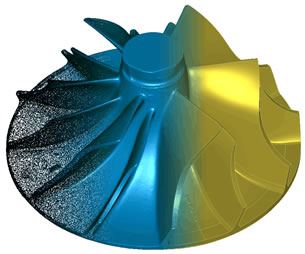 New features in Geomagic Studio 10x include new surface manipulation capabilities, improved registration algorithm for more accurate point clouds, and enhanced decimation algorithm for more efficient polygon models. |
Geomagic (Research Triangle Park, NC) is now shipping Geomagic Studio 10x, a new version of its 3D modeling software. Key enhancements in Geomagic Studio include new surface manipulation capabilities in the Fashion surfacing module and improved performance for point and polygon processing tools. Geomagic Studio 10x is available in three editions tailored to the needs of engineers in mechanical and industrial design, medical and scientific imaging, and engineering analysis.
The Geomagic Fashion module in Geomagic Studio 10x automatically identifies, analyzes, and corrects imperfections in 3D scan data to create high-quality geometric and freeform surfaces for further manipulation in CAD.
“Geomagic Studio 10x with Geomagic Fashion jump-starts the product development process by enabling designers to quickly and easily bring existing physical assets into the digital world,” says Karl Matthews, director of product management for Geomagic. “This is critical in a global marketplace where the leaders are increasingly defined by distinctive design, quality, time to market, and customization on a mass scale.”
| “Geomagic Studio 10x with Geomagic Fashion jump-starts the product development process by enabling designers to quickly and easily bring existing physical assets into the digital world.” — Karl Matthews, Geomagic, director of product management |
Major new features and enhancements to Geomagic Fashion include constrained surface-fitting capabilities for aligning surfaces and correcting imperfections in the as-built model or scan data. New automatic surface extension and trimming capabilities create sharp edges between neighboring surfaces, making edges and surfaces faster and easier to manipulate downstream in CAD. Plus, advanced tools enable users to exclude regions of a mesh that deviate from the desired surface classification, resulting in a more accurate representation of the digitized part, says the company.
Improved Polygon Models
Geomagic Studio 10x includes enhancements that improve performance and quality of point and polygon processing. An improved algorithm for registration helps users create more accurate point clouds from scan data, and a new decimation methodology produces smaller, yet still accurate, polygon models.
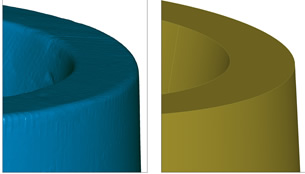 | |
| Original Data | Trimmed Surface |
| New automatic surface extension and trimming capabilities in the Fashion module for Geomagic Studio 10x create sharp edges between neighboring surfaces, making edges and surfaces faster and easier to manipulate downstream in CAD, according to the company. | |
Geomagic Studio 10x with Geomagic Fashion speeds, automates, and simplifies the workflow of transforming scan data into a Class A surface model, says Geomagic, adding that its capabilities make it a great complement to design tools such as Autodesk AliasStudio.
“Geomagic Studio 10x with Geomagic Fashion streamlines what was previously a time-consuming and tedious process of moving from points to polygons to Class A surfaces,” says Karl Matthews, director of product management for Geomagic. “In conjunction with AliasStudio, it allows designers to bypass challenging modeling procedures and concentrate on the design process.”
The Three Editions
Geomagic Studio - Fashion Edition lets users automatically extract design intent and create CAD-ready surfaces that are said to be intelligent. It is suited for both new design and re-engineering of existing parts. Geomagic Fashion guides you through the surfacing process in four steps that the company describes as easy.
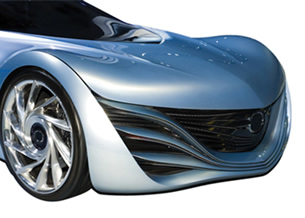 Geomagic Studio - Fashion Edition lets users extract design intent and create CAD-ready surfaces automatically. The resulting data is said to be suitable for both new design and re-engineering of existing parts. |
Step 1: Detect Regions — Geomagic Fashion automatically detects the different surface regions based on the curvature of the model. The contour curves are extracted and used to define the surface boundaries.
Step 2: Edit Contour Curves — Contour curves can be fine-tuned to ensure that they are optimally placed along edges and features. Contours not automatically extracted can be added manually by drawing directly on the mesh.
Step 3: Classify Regions — Primary surface regions are classified according to eight different surface types: planes, cylinders, cones, spheres, free-form surfaces, extrusions, drafted extrusions, and rotations. Each surface is displayed in a different color for easy identification.
Step 4: Create Surfaces — Finally, primary surfaces are fitted based on parameters such as fitting tolerance, outlier percentages, dimensions, and 2D profiles. Deviation analysis shows the accuracy of the fitted surfaces.
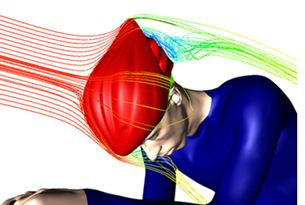 With Geomagic Studio - Shape Edition, you can create exact 3D replicas of organic objects. Its one-button surfacing creates watertight NURBS surfacing. |
With the Geomagic Studio - Shape Edition, you can create 3D replicas of organic objects such as bones or historical artifacts. One-button surfacing creates watertight NURBS surfacing. You can digitally reconstruct an infinite variety of complex real-world shapes more quickly and easily than ever before. Using 3D scan data of these objects, you’ll be able to create accurate models that capture all of the details of the original object, according to the company.
With Geomagic Shape surfacing, users can create NURBS surfaces in four steps:
Step 1: Detect Contours/ Curvature — Contour lines are created to break the object into regions of low curvature change that can be easily represented by a set of smooth patches.
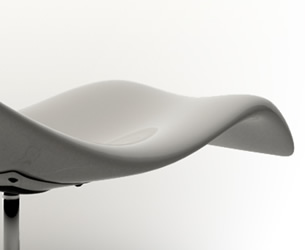 Geomagic Studio - Complete Edition allows users to extract design intent from existing objects and create exact replicas of as-built parts for FEA and CFD analysis. |
Step 2: Construct Patches — Four-sided patches are traced out on the polygonal surface. These patches function as a framework for constructing the NURBS surface.
Step 3: Construct Grids — The grid creation process places a grid within each of the defined boundary patches.
Step 4: Construct NURBS Surfaces — Finally, Geomagic Studio automatically computes NURBS surfaces to create a watertight model.
With Geomagic Studio Complete Edition you can do it all. This comprehensive edition includes everything found in the Fashion and Shape editions. With it, you can extract design intent from existing objects and create exact replicas of as-built parts for FEA and CFD analysis, enabling you to accelerate your design process by bringing your physical parts into the digital realm.
What’s new in Geomagic Studio 10x.
Read why DE’s editors chose this as a Pick of the Week.
Learn more about Geomagic Studio.
See Geomagic Studio in action.
Download Geomagic Studio brochure.
Find out which edition is right for you using the company’s comparison chart.
Register to request a free trial of Geomagic Studio.
Link directly to the webpage focused on Geomagic Studio — Fashion edition.
Link directly to the webpage focused on Geomagic Studio — Shape edition.
Link directly to the webpage focused on Geomagic Studio — Complete edition.
For previous DE coverage, see “Geomagic Studio 10X Speeds CAD-Ready Surfaces from 3D Scan Data,” (Dec. 2008).
Margaret S. Gurney is the editor for new products at Desktop Engineering magazine.
Subscribe to our FREE magazine, FREE email newsletters or both!
About the Author
DE’s editors contribute news and new product announcements to Digital Engineering.
Press releases may be sent to them via [email protected].






